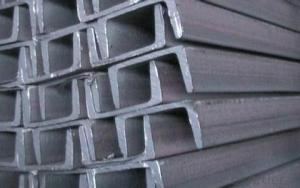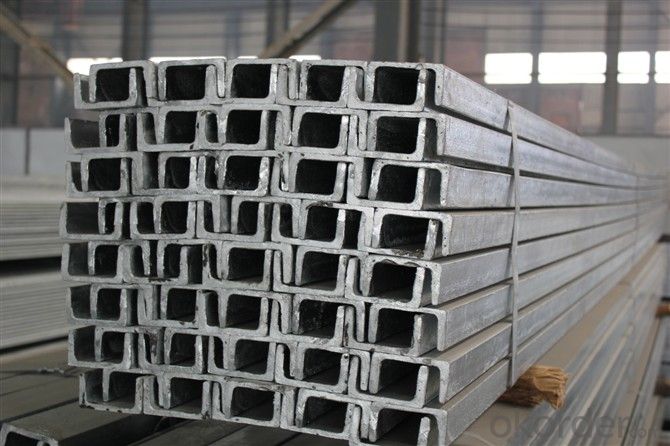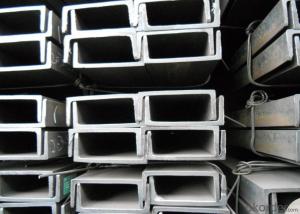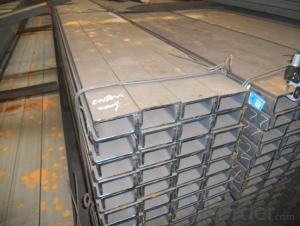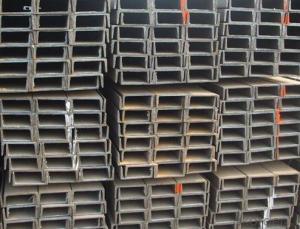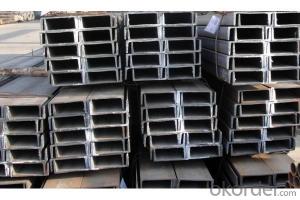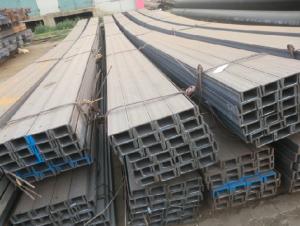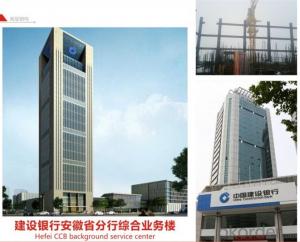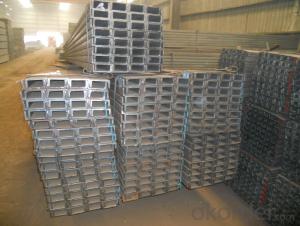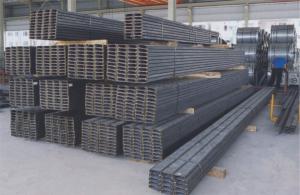steel channel for construction
- Loading Port:
- Tianjin
- Payment Terms:
- TT OR LC
- Min Order Qty:
- 1000 m.t.
- Supply Capability:
- 10000 m.t./month
OKorder Service Pledge
OKorder Financial Service
You Might Also Like
Product Description:
Steel U Channel Details:
Minimum Order Quantity: 25 Tons Unit: m.t. Loading Port: Xingang Port
Supply Ability: 1000 Tons Per Day Payment Terms: TT or L/C
Product Description:
Specifications of Steel U Channel:
Standard Applied: GB Standard, EN Standard(UPN), JIS Standard
Sizes: 50mm to 300mm
Material Grade: Q235B, Q345B, S235JR, SS400, ASTM A36
As shown in the figure:
Usage/Application of Steel U Channel:
The steel u channel can be applied to construction of warehouses, workshops, sport stadiums and car parks etc. In details, the steel u channel belongs to carbon structural steel which is applied to in the field of construction and machinery. The steel u channel is usually used for arch-itechtural structure, and they could be welded in order to support or hang a vari-ety of facilities. They are also usually used in combination with I beam. Generally,the steel u channel must possess perfect welding property, riveting property and mechanical property and so on.
Package & Delivery: Steel U Channel
The steel u channel will be packed in bundle with steel wire at each end of every bundle and color marking in order to help the customer to recognize his goods more easily at sight.
And steel u channel could be loaded into 20ft or 40ft container, or by bulk cargo. If the weight of each bundle reaches less than 3.5 mt, the loading by break bulk cargo should be choosed. When the weight of each bundle reaches less than 3mt, the loading by container should be choosed.
As for the transportaion from mill to loading port, the truck will be usually used. And the maximum quantity for each truck is 40mt.
All in all, we could do in accordance with customer's request
- Q: How do steel channels compare to timber or concrete channels?
- Steel channels have several advantages over timber or concrete channels. Firstly, steel channels have higher strength and load-bearing capacity compared to timber channels. This makes steel channels more suitable for heavy-duty applications and environments where there is a need for increased structural integrity. Secondly, steel channels are more resistant to corrosion and decay compared to timber channels. This makes steel channels a durable and long-lasting option, especially in environments with high moisture or exposure to chemicals. Furthermore, steel channels offer greater design flexibility as they can be easily shaped and welded to meet specific project requirements. This flexibility allows for efficient customization and installation, making steel channels a preferred choice for complex construction projects. Lastly, steel channels have a higher fire resistance compared to timber channels. In the event of a fire, steel channels are less likely to burn or contribute to the spread of flames, enhancing overall safety. Overall, steel channels provide superior strength, durability, versatility, and fire resistance when compared to timber or concrete channels, making them a preferred choice for many construction applications.
- Q: What is the allowable bending strength of Q235 channel steel? Why does the mechanical manual have no bending strength?
- The bending strength value is 235MPa, and the yield value decreases with the increase of the thickness of the material.The mechanical design manual is just some information about the design and the bending strength is a description of the performance of the steel.
- Q: Can steel channels be used for access ladders?
- Yes, steel channels can be used for access ladders. Steel channels are strong and durable, making them suitable for supporting the weight of individuals climbing up and down the ladder. Additionally, their shape provides stability and rigidity, ensuring a safe and secure ladder structure for accessing elevated areas.
- Q: Are steel channels suitable for use in industrial settings?
- Steel channels are an ideal choice for industrial settings due to their versatility and robustness. They provide excellent strength and stability, making them highly suitable for different applications in industrial environments. One of the main advantages of steel channels is their ability to bear heavy loads. Industrial settings often involve the use of heavy machinery, equipment, and materials, and steel channels can provide the necessary strong and durable support structures. They can withstand significant loads, ensuring a reliable framework for various industrial operations. Additionally, steel channels are known for their resistance to corrosion and weathering. In industrial settings, materials are frequently exposed to harsh conditions like moisture, chemicals, and extreme temperatures. Steel channels, especially those made from corrosion-resistant alloys, can withstand these environmental challenges and maintain their structural integrity over time. Another factor that makes steel channels suitable for industrial settings is their versatility. They come in different shapes, sizes, and thicknesses, allowing them to be adapted to various requirements and applications. Steel channels can be easily fabricated, cut, and welded to create customized structures that meet specific industrial needs. Moreover, steel channels offer excellent fire resistance, which is crucial in industrial environments where fire hazards are a concern. Steel has a high melting point and does not contribute to the spread of flames, making it a safe choice for industrial structures. Furthermore, steel channels are cost-effective in the long run. They are made from durable materials that require minimal maintenance, reducing the need for frequent repairs or replacements. Additionally, steel is widely available and can be recycled, making it an environmentally friendly choice. In conclusion, steel channels are highly suitable for industrial settings due to their strength, durability, resistance to corrosion and fire, versatility, and cost-effectiveness. Whether it's for supporting heavy loads, creating customized structures, or withstanding harsh environments, steel channels offer reliable and efficient solutions for various industrial applications.
- Q: Do steel channels have any specific load distribution characteristics?
- Yes, steel channels do have specific load distribution characteristics. Steel channels are commonly used in structural applications as they provide excellent strength and load-carrying capacity. The load distribution characteristics of steel channels depend on their shape, size, and orientation. Steel channels typically have a C-shaped cross-section, with a flat back and two perpendicular flanges. The load distribution characteristics of steel channels are primarily influenced by the flanges. The flanges act as beams that resist bending and carry the applied load. The load is distributed along the length of the flanges, creating a load path that transfers the load to the supports or other structural elements. The load distribution characteristics of steel channels are also influenced by the size and orientation of the channel. Larger channels with wider flanges can distribute the load over a larger area, reducing the stress concentration. Additionally, the orientation of the channel, whether it is vertical or horizontal, can affect the load distribution characteristics. It is important to consider the load distribution characteristics of steel channels during the design and analysis of structures. Engineers need to ensure that the channels are properly sized and oriented to adequately distribute the applied loads. By considering these characteristics, steel channels can effectively distribute the load and contribute to the overall structural integrity and stability of a construction project.
- Q: What are the different types of coatings available for steel channels?
- There are several types of coatings available for steel channels, including galvanized coatings, paint coatings, powder coatings, and epoxy coatings.
- Q: Do steel channels have any specific vibration damping properties?
- Steel channels do not have specific vibration damping properties. However, the inherent stiffness and mass of steel channels can help absorb and dissipate vibrations to some extent. Additional measures such as using rubber or elastomer pads between steel channels and other vibrating components can further enhance their vibration damping capabilities.
- Q: Are steel channels suitable for commercial construction projects?
- Yes, steel channels are suitable for commercial construction projects. They are widely used in the construction industry due to their high strength, durability, and versatility. Steel channels provide structural support, are resistant to fire and corrosion, and can be easily customized to meet specific project requirements. Additionally, steel channels offer cost-effective solutions for commercial construction, making them a popular choice among architects and builders.
- Q: Can steel channels be used in power plant construction?
- Yes, steel channels can be used in power plant construction. Steel channels provide structural support and can be used for various applications such as framing, reinforcement, and conduit systems in power plant construction. They offer strength, durability, and versatility, making them suitable for the demanding and high-load requirements of power plant infrastructure.
Send your message to us
steel channel for construction
- Loading Port:
- Tianjin
- Payment Terms:
- TT OR LC
- Min Order Qty:
- 1000 m.t.
- Supply Capability:
- 10000 m.t./month
OKorder Service Pledge
OKorder Financial Service
Similar products
Hot products
Hot Searches
Related keywords
